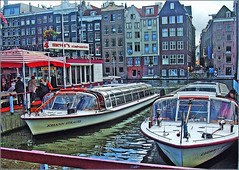 Image by bill barber via Flickr
Image by bill barber via FlickrFinally, we are in Amsterdam! Around we see buildings which are not too tall, 4-5 storeys, but old and original in style, apparently, built with love and for the ages. The design and style are very unusual, with red, white yellow and brown colors and high roofs covered with tiles. After passing a narrow street called Paulus Potter Straat we see amazing trams of different styles, types and colors shuttling back and forth.
Now we reach one of the most stylish places in Amsterdam, opposite the National Museum (Rijksmuseum). Nearby there is an artificial lake with people resting on the lawn in different postures: lying, sitting, chewing, reading, and conversing. They were all indulging in rest and did not pay any attention to what was happening around, people walking and dogs running. Even further I saw a modern cubic building of the Van Gogh Museum with a large green field behind, crowded with people spending their leisure time.
Our tourist group, according to the program, was taken to the Royal Diamond Museum (free admission). We entered there but just in two minutes I realized that this museum is not worth seeing at all (Internet forums were speaking of it as a waste of time), and we decided to skip it and explore the environs. They were picturesque: right behind the building of the State Museum we came to one of the famous canals of Amsterdam, so quiet and colorful. Next to it there was the historic first brewery of Heineken Brouvertji, a gloomy dark-brown building. It was here that they first began to brew Heineken, now a world-class beer brand. Our next stop was a park (or rather, a green field) where I noticed how much litter was there around the city, which is strikingly different from Germany, for example. Lawns were covered with chewing gum wrappers, scraps of newspapers, just like in so many cities I have seen before where cleanness is not worshipped. Also, it turned out that finding a clean toilet in Amsterdam is quite a challenge.
After making a large circle we soon walked out to the Van Gogh Museum on its reverse side. Next to it we found busy souvenir shops selling products associated with the name of the genius artist from Amsterdam: reproductions of his paintings (10 euros), shirts (14-15 euros), mugs (5-6 euros), posters (5.4 euros), e-cards (0,5-1,5 euros) etc. Everything was fairly pricey. The Europeans are good at making money on souvenirs, I have noticed that long ago.
Very interesting was a tour through Amsterdam aboard a river tram with an open deck. After all canals, a calling card of the capital of the Netherlands. They have all been dug over the last 400 years, in concentric semicircles around the Gulf coast. On them, around 1200 bridges (!) were built, of which 400 in the historic city center. The City Centre is located on 70 artificial islands, many of them were not in existence 300 years ago, and now people live where it used to be an open sea.
We left from the river buses pier near the historic brewery Heineken, along the canal Singelgracht. Along the canal banks we saw small wooden barges, which are used as private homes: with verandas, flower-beds, and all the amenities inside. It looked very strange when you see the decks of these houses with sitting, walking or standing people who were drinking tea, watering their flowers, sweeping floors, that is, living a normal life and completely ignoring the trams with crowds of tourists staring at them. We were told that living in such homes on water is considered very prestigious in Amsterdam, and such apartments are in high demand. Such dwellings came to existence after the Second World War, when there was a shortage of housing and the city government temporarily allowed to build homes on water. Truly, there is nothing more permanent than temporary.
The canal through which we were sailing joined the bigger river Amstel, and right before us opened a majestic view of the river and the luxury hotel Amstel which sits on piles in water.
The magnificent buildings along the river originate from the Golden Age of Holland, the 17th century, when all this splendor was created. In those days, wealth just flocked to Amsterdam, as the Dutch East India Company controlled the world trade in spices from the Molucca Islands in Indonesia, making untold profits.
Leaving the harbor we passed by a giant snow-white ship hotel and at the distance we could see a huge green building of a business center with unusual architecture. Amsterdam citizens call this building 'Titanic' for its characteristic shape. Then, at the end of our tour, we saw a huge Chinese restaurant in the shape of a pagoda with 4 tiers, standing right on the water, an exact copy of the same restaurant in Hong Kong.
Planning a trip to Amsterdam? Be sure to check information about Amsterdam hotels, with descriptions, rates, photos, and visitors reviews.
Source: http://www.submityourarticle.com
Permalink: http://www.submityourarticle.com/a.php?a=125238
